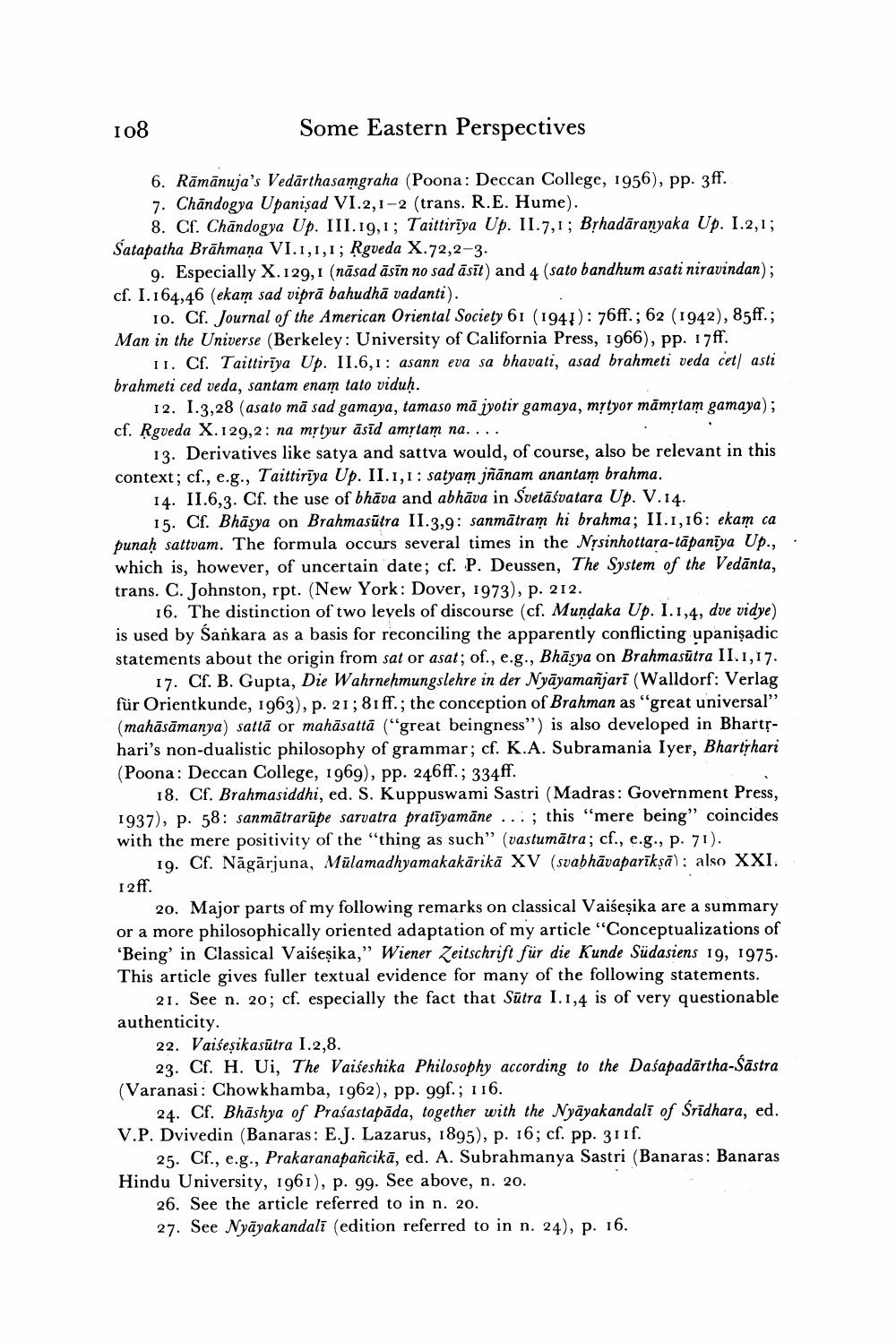________________
108
Some Eastern Perspectives
6. Rāmānuja's Vedārthasamgraha (Poona: Deccan College, 1956), pp. 3ff. 7. Chāndogya Upanişad VI.2, 1-2 (trans. R.E. Hume).
8. Cf. Chāndogya Up. III.19,1; Taittirīya Up. II.7,1; BỊhadāranyaka Up. I.2,1; Satapatha Brāhmaṇa VI.1,1,1; Rgveda X.72,2-3.
9. Especially X. 129,1 (nāsad āsīn no sad āsīt) and 4 (sato bandhum asati niravindan); cf. 1. 164,46 (ekam sad viprā bahudhā vadanti).
10. Cf. Journal of the American Oriental Society 61 (1941): 76ff.; 62 (1942), 85ff.; Man in the Universe (Berkeley: University of California Press, 1966), pp. 17ff.
11. Cf. Taittirīya Up. II.6,1: asann eva sa bhavati, asad brahmeti veda cet/ asti brahmeti ced veda, santam enam tato viduh.
12. 1.3,28 (asato mā sad gamaya, tamaso mā jyotir gamaya, mịtyor māmstam gamaya); cf. Řgveda X.129,2: na mrtyur āsīd amstam na....
13. Derivatives like satya and sattva would, of course, also be relevant in this context; cf., e.g., Taittirīya Up. II.1,1: satyam jñānam anantam brahma.
14. 11.6,3. Cf. the use of bhāva and abhāva in Svetāśvatara Up. V.14.
15. Cf. Bhāsya on Brahmasūtra II.3,9: sanmātram hi brahma; II.1,16: ekam ca punaḥ sattvam. The formula occurs several times in the NȚsinhottara-tāpanīya Up., . which is, however, of uncertain date; cf. P. Deussen, The System of the Vedānta, trans. C. Johnston, rpt. (New York: Dover, 1973), p. 212.
16. The distinction of two levels of discourse (cf. Mundaka Up. I. 1,4, dve vidye) is used by Sankara as a basis for reconciling the apparently conflicting upanișadic statements about the origin from sat or asat; of., e.g., Bhāsya on Brahmasūtra II. 1,17.
17. Cf. B. Gupta, Die Wahrnehmungslehre in der Nyāyamañjarī (Walldorf: Verlag für Orientkunde, 1963), p. 21; 81ff.; the conception of Brahman as "great universal” (mahāsāmanya) sattā or mahāsattā (“great beingness”) is also developed in Bhartrhari's non-dualistic philosophy of grammar; cf. K.A. Subramania Iyer, Bhartrhari (Poona: Deccan College, 1969), pp. 246ff.; 334ff.
18. Cf. Brahmasiddhi, ed. S. Kuppuswami Sastri (Madras: Government Press, 1937), p. 58: sanmātrarūpe sarvatra pratīyamāne ... ; this "mere being" coincides with the mere positivity of the "thing as such” (vastumātra; cf., e.g., p. 71).
19. Cf. Nāgārjuna, Mūlamadhyamakakārikā XV (svabhāvaparīkņā): also XXI. 12ff.
20. Major parts of my following remarks on classical Vaiseșika are a summary or a more philosophically oriented adaptation of my article “Conceptualizations of 'Being' in Classical Vaiseșika,” Wiener Zeitschrift für die Kunde Südasiens 19, 1975. This article gives fuller textual evidence for many of the following statements.
21. See n. 20; cf. especially the fact that Sūtra 1.1,4 is of very questionable authenticity.
22. Vaiseșikasūtra 1.2,8.
23. Cf. H. Ui, The Vaiseshika Philosophy according to the Dasapadārtha-Šāstra (Varanasi: Chowkhamba, 1962), pp. 99f.; 116.
24. Cf. Bhāshya of Prasastapāda, together with the Nyāyakandalī of Śrīdhara, ed. V.P. Dvivedin (Banaras: E.J. Lazarus, 1895), p. 16; cf. pp. 311f.
25. Cf., e.g., Prakaranapañcikā, ed. A. Subrahmanya Sastri (Banaras: Banaras Hindu University, 1961), p. 99. See above, n. 20.
26. See the article referred to in n. 20. 27. See Nyāyakandali (edition referred to in n. 24), p. 16.




